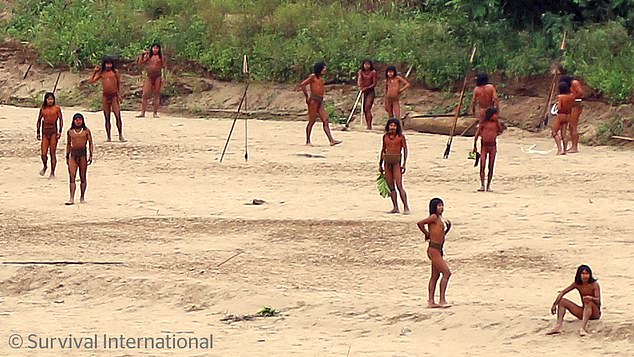Members of an “uncontacted” Amazonian indigenous tribe used bows and arrows to attack loggers in a fight that left at least one person injured.
The violent clash comes just weeks after the group known as Mashco Piro was seen brandishing spears on the banks of a river in a remote part of Peru.
Activists have warned that the tribe, believed to be the world’s largest uncontacted group, is under siege by logging activity that is disrupting their rainforest home.
The fight took place at an illegal logging camp outside their Madre de Dios territorial reserve, along the Pariamanú River, on July 27, a local indigenous organization said.
However, no further details are clear and there are unconfirmed reports that two loggers may have been killed.
The Mashco Piro were seen brandishing spears on the banks of a river in remote Peru (photo from June)

Survival fears the tribe is moving out of the rainforest due to logging in the area (pictured June)

Tribe members rest on the riverbanks while others carry spears and stop to interact (pictured, June)
Teresa Mayo, a researcher in Peru for Survival International, an NGO that supports indigenous groups, said the clash occurred in an area of rainforest that is not formally protected by the government, although it is considered Mashco Piro territory.
The incredible video released by Survival International last month shows around 50 men and boys standing on the dusty riverbank, dressed in loincloths, with long hair and bare feet stained with limestone from the rough ground.
The group is in small groups, some jogging to pick up large spears lying on the ground. Others talk, gesture and help carry objects across the river.
“These incredible images show that large numbers of uncontacted Mashco Piro are living alone just a few kilometres from where loggers are about to begin operations,” said Caroline Pearce, Survival International’s director at the time.
The Mashco Piro tend to appear infrequently and do not communicate much with anyone, according to the NGO.

Rare photos show the tribe emerging from the rainforest and interacting on the riverbanks (June photo)

Experts fear the tribe could be driven from their homes by nearby logging activity (June photo)

The tribe rarely interacts even with other tribes and remains isolated in a small territory in southeastern Peru (pictured in June).
Several logging companies have logging concessions within the territory inhabited by the Mashco Piro.
One company, Canales Tahuamanu, has built more than 200 kilometres (120 miles) of roads for its logging trucks to extract timber, according to Survival International.
The company is certified by the Forest Stewardship Council, according to which it has 53,000 hectares (130,000 acres) of forests in Madre de Dios to extract cedar and mahogany.
In 2022, members of the Mashco Piro tribe shot two Catahua workers with bows and arrows while they were fishing in the Tahuamanu River, killing one.
Survival International is now calling on the Forest Stewardship Council (FSC) to withdraw its certifications from Catahua operations and is asking for support to help protect uncontacted tribes.
The Mashco Piro have also been sighted across the border in Brazil, said Rosa Padilha of the Indigenous Missionary Council of Brazilian Catholic bishops in Acre state.
“They are fleeing from loggers on the Peruvian side,” he said.

Two years ago, members of the tribe clashed with loggers and shot two of them with arrows while they were fishing in a river (June photo).


The tribe was seen in rare footage of June walking along the banks of a river in the Madre de Dios region of Peru (photo June)
‘At this time of year they appear on the beaches to take the eggs (of Amazonian turtles). That’s when we find their footprints in the sand. They leave behind a lot of turtle shells.’
“They are a people who have no peace, restless, because they are always fleeing,” said Padilha.
According to Survival, there are more than 100 uncontacted tribes around the world, but many of them are now facing extinction due to habitat destruction by outsiders.
Survival International warns that the Peruvian government has yet to enact into law several indigenous territories on which these groups depend for their survival.
At the other end of the world, tribes are facing similar fears. In Indonesia, the Hongana Manyawa are at risk of being evicted from their home, which sits atop the world’s largest nickel deposit on the island of Halmahera.
Some emerged from isolation for the first time to beg for food from miners as they cleared their way through the forest to make way for new mines.
Survival International warned that it does not know how long the tribe will be able to survive after the encounter.
Contact with outsiders can be life-threatening due to exposure to new diseases to which isolated individuals would not have developed resistance.


